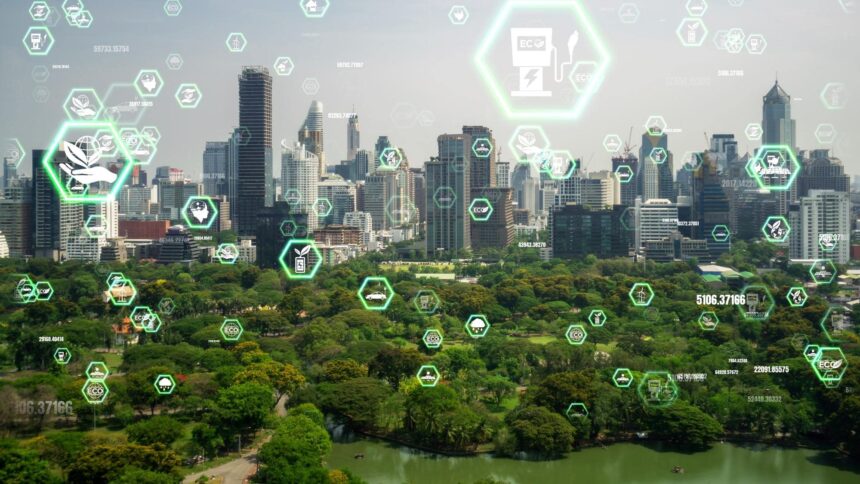In the evolving landscape of modern cities, smart cities are becoming the blueprint for sustainable urban development. These cities leverage cutting-edge technologies, particularly the Internet of Things (IoT), to enhance the quality of life, improve public services, and create a more sustainable environment. As the global population continues to urbanize, the need for efficient, livable, and eco-friendly urban spaces is more pressing than ever.
A smart city integrates advanced digital technologies to manage resources efficiently, optimize energy usage, and reduce waste. IoT, a network of interconnected devices and sensors, plays a pivotal role in enabling this transformation. From smart grids to intelligent transportation systems, the applications of IoT in smart cities are vast and transformative. In this post, we will explore how IoT technology can shape sustainable urban development and what it means for the future of cities worldwide.
What Are Smart Cities?
At their core, smart cities utilize technology and data to improve urban life and manage resources more effectively. They combine a wide array of technologies like IoT, big data analytics, cloud computing, and artificial intelligence (AI) to create a connected urban ecosystem. These systems enable cities to be more responsive, efficient, and sustainable, creating a harmonious relationship between residents, technology, and the environment.
In a smart city, everything from traffic lights and street lamps to waste management systems and energy grids is interconnected. This enables local governments to monitor and control city infrastructure in real-time, making data-driven decisions to improve services, reduce operational costs, and enhance the overall quality of life. By collecting and analyzing data from various sources, smart cities can address critical challenges such as overcrowding, pollution, and resource scarcity while fostering economic growth and environmental sustainability.
The Role of IoT in Smart Cities
The Internet of Things (IoT) serves as the backbone of smart cities, creating a network of interconnected devices that communicate and share data seamlessly. IoT technology allows urban planners and governments to gather real-time data from sensors embedded in city infrastructure, enabling them to monitor everything from air quality to traffic flow and energy consumption.
IoT-powered devices such as smart meters, traffic sensors, and weather stations provide valuable insights into how resources are used and how the city functions. With this data, cities can make informed decisions that optimize resource allocation, improve services, and reduce waste. For instance, smart traffic systems can adjust traffic lights based on real-time traffic conditions, reducing congestion and pollution. Similarly, smart grids can manage electricity usage more efficiently, reducing energy consumption and lowering costs for residents.
In addition, IoT devices can enhance public safety by monitoring environmental hazards such as air pollution, flooding, or fires. Sensors installed in strategic locations can detect these risks and send real-time alerts to authorities, allowing them to respond quickly and mitigate damage. In this way, IoT technology is not only improving the quality of life in smart cities but also fostering a safer and more sustainable environment for all.
Sustainable Urban Development: A Key Objective of Smart Cities
One of the primary goals of smart cities is to achieve sustainable urban development. As urban populations grow, cities face increasing challenges related to resource management, environmental degradation, and climate change. Smart cities aim to address these challenges by using technology to reduce energy consumption, promote renewable energy sources, and enhance waste management practices.
Through the use of IoT, smart cities can monitor and manage their energy consumption more effectively. Smart meters allow residents and businesses to track their energy use in real-time, promoting energy conservation and reducing waste. At the same time, smart grids enable cities to distribute electricity more efficiently, reducing the reliance on non-renewable energy sources and promoting the use of solar, wind, and other sustainable energy options.
In terms of waste management, smart cities use IoT sensors to monitor waste levels in dumpsters and trash bins. This data enables waste management services to optimize collection routes, reducing fuel consumption and lowering carbon emissions. Furthermore, smart waste management systems can also track recyclable materials, encouraging residents to recycle more and reduce landfill waste.
Improving Mobility and Transportation
Efficient transportation systems are crucial for the success of smart cities, especially as urban populations continue to rise. Traditional transportation infrastructure often leads to congestion, pollution, and long commute times. By incorporating IoT technologies, smart cities can revolutionize mobility, making transportation more efficient, sustainable, and accessible.
IoT-enabled traffic management systems are a key component of smart transportation. Sensors embedded in roads, traffic lights, and vehicles collect real-time data on traffic flow, congestion, and accidents. This data is analyzed and used to optimize traffic signals, reduce congestion, and improve road safety. For example, traffic lights can be adjusted in real-time to prioritize emergency vehicles or alleviate congestion during rush hours.
In addition, smart cities are increasingly adopting electric vehicles (EVs) and autonomous vehicles (AVs) as part of their transportation solutions. IoT technology enables the seamless integration of these vehicles into the city’s transportation network. For instance, autonomous vehicles can communicate with traffic management systems to navigate the city more efficiently, while EV charging stations are connected to smart grids that optimize energy use.
Public transportation is also enhanced in smart cities through IoT. Smart buses, trains, and subways are equipped with GPS and sensors to provide real-time updates on arrival times, delays, and seat availability. This helps commuters plan their journeys more effectively and reduces wait times.
The Impact on the Environment

One of the most significant benefits of smart cities is their ability to mitigate the environmental impact of urbanization. By integrating IoT technology into city infrastructure, cities can monitor and manage environmental factors such as air quality, noise pollution, and water usage more effectively.
IoT sensors can detect pollution levels in real-time, providing valuable data that can help authorities take action to reduce harmful emissions. For example, if air quality drops below a certain threshold, cities can issue public health warnings and implement measures such as temporary traffic restrictions or the promotion of public transportation.
In addition to improving air quality, smart cities can reduce water consumption by implementing IoT-powered smart water management systems. These systems monitor water usage in real-time, detect leaks, and optimize irrigation schedules, ensuring that water resources are used efficiently and wastefully.
Smart Healthcare in Urban Environments
As part of their commitment to enhancing quality of life, smart cities are increasingly focusing on improving healthcare services through IoT technology. By integrating IoT devices into healthcare systems, cities can provide more efficient and accessible healthcare services to their residents.
IoT devices such as wearable health monitors, smart thermometers, and remote patient monitoring systems allow doctors to track patients’ health conditions in real-time. This data can be used to predict health issues, intervene early, and provide personalized care, reducing the burden on healthcare facilities.
In addition, smart healthcare systems can help optimize hospital operations. IoT-enabled devices track medical equipment, monitor patient flow, and manage medication inventory, ensuring that hospitals can operate more efficiently and provide better care to patients.
Challenges and Future Outlook
While smart cities offer numerous benefits, the widespread adoption of IoT technology in urban development also presents certain challenges. One of the key obstacles is ensuring data privacy and security. With millions of connected devices generating vast amounts of data, cities must implement robust cybersecurity measures to protect sensitive information and prevent cyber-attacks.
Another challenge is the significant upfront investment required to build the infrastructure for smart cities. While the long-term benefits are clear, cities must secure funding and plan for the integration of new technologies into existing urban systems.
Despite these challenges, the future of smart cities is promising. As technology continues to advance, cities will become more connected, efficient, and sustainable. The integration of IoT and other emerging technologies will allow cities to adapt to the changing needs of urban populations while minimizing their environmental impact.
Conclusion: Building Smart Cities for a Sustainable Future
In conclusion, smart cities powered by IoT technology hold immense potential to transform urban living and create more sustainable, efficient, and livable environments. By harnessing the power of interconnected devices and data-driven decision-making, cities can tackle pressing challenges like resource scarcity, pollution, and traffic congestion, all while improving the quality of life for their residents.
As we look to the future, it’s clear that the smart city revolution is just beginning. With continued innovation and collaboration between governments, businesses, and citizens, we can build cities that are not only smarter but also more sustainable and resilient. The shift toward smart cities represents a crucial step in creating urban environments that can thrive in an increasingly digital and eco-conscious world.
